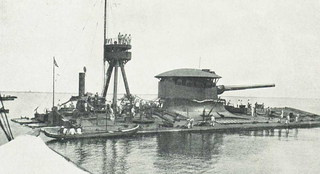 W
WThe Yugoslav monitor Drava was a river monitor operated by the Royal Yugoslav Navy between 1921 and 1941. She was originally built for the Austro-Hungarian Navy as the name ship of the Enns-class river monitors. As SMS Enns, she was part of the Danube Flotilla during World War I, and fought against the Serbian and Romanian armies from Belgrade to the lower Danube. In October 1915, she was covering an amphibious assault on Belgrade when she was holed below the waterline by a direct hit, and had to be towed to Budapest for repairs. After brief service with the Hungarian People's Republic at the end of the war, she was transferred to the newly created Kingdom of Serbs, Croats and Slovenes, and renamed Drava. She remained in service throughout the interwar period, but was not always in full commission due to budget restrictions.
 W
WThe Enns-class river monitors were built for the Austro-Hungarian Navy during the mid-1910s. The two ships of the class were assigned to the Danube Flotilla and participated in World War I. The ships survived the war and were transferred to Romania and the newly created Kingdom of Serbs, Croats and Slovenes as reparations.
 W
WFaà di Bruno was an Italian monitor built during World War I. Completed in 1917, the ship played a small role in the 11th Battle of the Isonzo later that year. She was decommissioned in 1924, but returned to service as the floating battery GM 194 at the beginning of World War II and was towed to Genoa and where she spent the rest of the war. The ship had her guns disabled when the Royal Navy bombarded Genoa in 1941. GM 194 was captured by the Germans after the Italian Armistice in 1943 and was turned over to the puppet Repubblica Sociale Italiana that they installed afterward. She was scuttled at the end of the war and subsequently scrapped.
 W
WSMS Körös was the name ship of the Körös-class river monitors built for the Austro-Hungarian Navy. Completed in 1892, the ship was part of the Danube Flotilla, and fought various Allied forces from Belgrade down the Danube to the Black Sea during World War I. After brief service with the Hungarian People's Republic at the end of the war, she was transferred to the newly created Kingdom of Serbs, Croats, and Slovenes, and renamed Morava. She remained in service throughout the interwar period, although budget restrictions meant she was not always in full commission.
 W
WThe Yugoslav monitor Sava is a Temes-class river monitor that was built for the Austro-Hungarian Navy as SMS Bodrog. She fired the first shots of World War I just after 01:00 on 29 July 1914, when she and two other monitors shelled Serbian defences near Belgrade. She was part of the Danube Flotilla, and fought the Serbian and Romanian armies from Belgrade to the mouth of the Danube. In the closing stages of the war, she was the last monitor to withdraw towards Budapest, but was captured by the Serbs when she grounded on a sandbank downstream from Belgrade. After the war, she was transferred to the newly created Kingdom of Serbs, Croats and Slovenes, and renamed Sava. She remained in service throughout the interwar period, although budget restrictions meant she was not always in full commission.
 W
WThe Sava-class river monitors were built for the Austro-Hungarian Navy during the mid-1910s. The two ships of the class were assigned to the Danube Flotilla and participated in World War I. The ships survived the war and were transferred to Romania and the newly created Kingdom of Serbs, Croats and Slovenes as reparations.
 W
WVardar was a Sava-class river monitor built for the Austro-Hungarian Navy as SMS Bosna, but was renamed SMS Temes (II) before she went into service. During World War I, she was the flagship of the Danube Flotilla, and fought the Serbian Army, the Romanian Navy and Army, and the French Army. She reverted to the name Bosna in May 1917, after the original SMS Temes was raised and returned to service. After brief service with the Hungarian People's Republic at the end of the war, she was transferred to the newly created Kingdom of Serbs, Croats and Slovenes, and renamed Vardar. She remained in service throughout the interwar period, although budget restrictions meant she was not always in full commission.